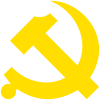Central Party School of the Communist Party of China
Coordinates: 40°00′25″N 116°16′49″E / 40.007007°N 116.280241°E
| 中共中央党校 | |
 | |
| Type | Communist Party of China |
|---|---|
| Established | 1933 |
| President | Liu Yunshan |
| Vice-president | He Yiting (executive) |
| Students | 1300 |
| Location | Beijing, China |
| Campus | Urban: Haidian |
| Colors | |
| Affiliations | Central Committee of the Communist Party of China |
| Website |
www |
| Central Party School of the Communist Party of China | |||||||
| Simplified Chinese | 中共中央党校 | ||||||
|---|---|---|---|---|---|---|---|
| Traditional Chinese | 中共中央黨校 | ||||||
| |||||||
The Party School of the Central Committee of the Communist Party of China in Beijing, also known as the Central Party School, is the higher education institution which specifically trains officials for the Communist Party of China.[1] As of 2012, it has around 1,600 students. The current president is Liu Yunshan, a member of the Politburo Standing Committee, China's top decision-making body.
History
The Party School was established as the CPC Central Committee's Marx School of Communism (simplified Chinese: 中共中央马克思共产主义学校; traditional Chinese: 中共中央馬克思共產主義學校; pinyin: Zhōnggòng Zhōngyāng Mǎkèsī Gòngchǎnzhǔyì Xuéxiào) in Ruijin, Jiangxi in 1933. It folded when the Red Army left on the Long March and was revived again once the CPC leadership had arrived and settled in Shaanxi, northwest China, in the winter of 1936. It was then renamed the Central Party School. The School was suspended in 1947 when the CPC retreated from Yan'an. It was re-opened in 1948 in a village in Pingshan County, Hebei province, before being moved to Beijing after the Communists captures the city in 1949.[2]
In 1955 the school was re-organized so that it came directly under the jurisdiction of the Central Committee of the Communist Party of China. Then in 1966 the school was abolished during the Cultural Revolution, before being duly restored in 1977. Since 1989 the school has been headed by the top-ranked Secretary of the Secretariat, who is concurrently a member of the Politburo Standing Committee. In practice the day-to-day affairs of the school is managed by the executive vice president, who is generally regarded to have the same ranking as a cabinet minister.
The school is, as of 2012, allowed to grant master's degrees in 14 subject areas and doctorate degrees in eight subject areas.
Location
The location of the school is now in Haidian district, Beijing close to the Old Summer Palace and Summer Palace. 100 Dayouzhuang Street, Haidian district, Beijing.
Presidents
- Li Weihan (李维汉): 1933–1935
- Dong Biwu (董必武): 1935–1937
- Li Weihan (李维汉): 1937–1938
- Kang Sheng (康生): 1938–1939
- Deng Fa (邓发): 1939–1942
- Mao Zedong: 1942–1947
- Liu Shaoqi (刘少奇): 1948–1953
- Kai Feng (凯丰): 1953–1954
- Li Zhuoran (李卓然): 1954–1955
- Yang Xianzhen (杨献珍): 1955–1961
- Wang Congwu (王从吾): 1961–1963
- Lin Feng (林枫): 1963–1966
- Hua Guofeng (华国锋): 1977–1982
- Wang Zhen (王震): 1982–1987
- Gao Yang (高扬): 1987–1989
- Qiao Shi (乔石): 1989–1993
- Hu Jintao (胡锦涛): 1993–2002
- Zeng Qinghong (曾庆红): 2002–2007
- Xi Jinping (习近平): 2007–2013
- Liu Yunshan (刘云山): 2013-incumbent
See also
References
- ↑ Liu, Alan P. L. 2009. "Rebirth and Secularization of the Central Party School in China." The China Journal (62): 105-0_5. http://search.proquest.com/docview/222740035
- ↑ Shambaugh, David. 2008. "Training Chinas Political Elite: The Party School System." The China Quarterly 196 (03057410): 827–844. doi:10.1017/S0305741008001148. http://search.proquest.com/docview/229490701
